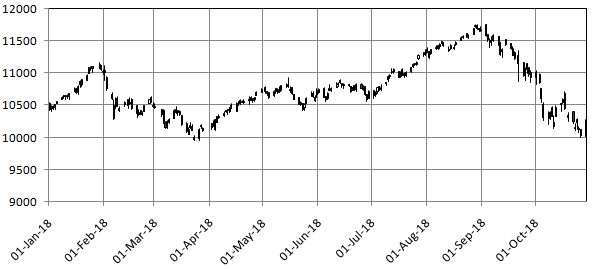Zones of support

Zone of support is the price zone from where stocks bounce back after falling. Traders usually like to buy stocks in this zone. For Nifty – 50 this year so far, the 10,000 mark has formed a zone of support. Though the market has been quite volatile, we have a seen a few pullbacks from the 10,000 levels this year. The Nifty opened the year at around 10,500. We saw some volatility after the budget and then market recovered to make its all time high around the 11,700 levels. The market turned volatile again in September 2018 and we saw a big sell off in the last 2 months, with Nifty falling more than 10%, but once Nifty neared 10,000 level, we saw some buying interest and 10,000 has not be breached on the downside so far in this round. The daily price chart of Nifty shows clearly that 10,000 is a zone of comfort.

Some investors, particularly those who are traders, base their investment decisions (buy or sell) on zones of support or resistance. In this blog post, we will discuss whether you should base your investment decisions on price movements approaching zones of support (or resistance). Please note that, we will discuss this topic from the point of view of long term investors (investment tenor of at least 3 years).
Zone of support
Support zone is a technical analysis concept, representing a boundary of low price, which has not been breached in previous trading sessions over a period of time. There can be different zones of support. The most common zone of support is the trend line of the lows made by the stock or index over the time-frame which investors look at (3 months, 6 months, year to date, 1 year etc).
Some traders look at the 50 Day Simple Moving Average, popularly known in trading parlance as 50 DMA as an important zone of support or resistance, depending on the direction of the market movement. If stock price is above 50 DMA, market is considered bullish and 50 DMA is considered to be a support level. If stock price is below 50 DMA, market is considered bearish and 50 DMA is considered to be a resistance level.
Some traders treat Bollinger bands as support and resistance. Bollinger bands are usually 2 standard deviations (both plus and minus) away from the 20 day moving average. The upper band is considered to be a zone of resistance and the lower band is considered to be a zone of support. Some traders use put call ratio, the volume of puts to calls trading in the market to determine whether the market is in overbought or oversold zone and therefore, indicate price reversal. If put call ratio is too high (high demand for puts), traders take this as a signal of oversold market and vice versa.
Sometimes round figures like 8000, 9000 or 10000 are considered to be important psychological levels for the index (e.g. Nifty). In the current market, for example, the 10,000 level is believed to be a zone of support for Nifty. We have discussed several methods used to traders to determine potential zones of price reversals and many more of them. Next time, you hear a stock market expert giving his market views on TV, hopefully you will be able to relate better to some of the technical terms used by him, but the more moot point for you is where these zones / indicators are at all relevant for you as a long term investor.
Zones of support (and resistance) are not sacrosanct
There is a saying in trading that levels are made to be broken. In a bear market, when panic sets in support zones are breached like a knife cutting through butter and when the mood is euphoric (bull market) resistance zones are breached in gap up openings.
Take a simple example - Nifty made an all time high in August 2018 and experts were saying 11,000 would be an important support zone. Did Nifty respect this support zone? There was not even a minor pullback from 11,000; the market simply kept falling. Therefore, unless you are short term trader who trades with tight stop-losses, you should not base you investment decisions on these levels. Further, there can be so many different support and resistance zones for the same stock that it will be difficult for you which level to base your investment decisions on.
Efficient Market Hypothesis
Efficient market hypothesis says that stock prices factor in all known information. Zones of support and resistance, whatever the method used to determine them, are publicly available information. This information is already factored in stock prices and therefore, price movement from support or resistance level will be based on new information. The new information may be in the form of Government or central bank (e.g. US Fed, RBI etc) announcements, corporate announcements or news, new economic data release etc.
Efficient market hypothesis suggests that the price movements at any point of time will be based on new information and not past price / volume data. Some experts may cite Nifty’s minor pullback rally from 10,000 as a sign of strong support in that zone. It might be simply a case of coincidence, because Nifty’s pullback rally from 10,000 was triggered by RBI’s announcement of its Government Bond purchase program which will inject liquidity in the market.
Lump Sum versus SIP
Some investors believe that technical analysis is relevant for lump sum investments. In our view, it is not relevant for lump sum investments because there is no sufficiently strong statistical evidence of strong one-way price movements from different support levels, except bear market bottoms. Bear market bottoms are almost impossible to predict and the confirmation of a bottom is made, only when the prices have recovered sufficiently.
Even if we assume for the sake of argument that price reversals take place from zones of support (or resistance), is it relevant for long term investors? Prices can move 4 – 5% in a few days, but this movement is hardly relevant for your long term financial goals. If you are expecting 15% CAGR returns over 5 or 10 years, then 4 – 5% movement on either upside or downside is inconsequential for you.
If you are investing through Systematic Investment Plan, then these levels are irrelevant because you are averaging your price of purchase (Rupee cost Averaging) by taking advantage of price volatility in equities. If you stop your SIP in a resistance zone and wait for the price to reverse to the support zone, you may have to wait indefinitely. The wealth creation potential of SIP is in the power of compounding. If you stop / start investment based on resistance / support levels, then you will not be able to leverage the power of compounding.
Conclusion
In this post, we discussed about the zones of support for stock / index prices and whether they are relevant for long term investors. You should invest in stocks based on its earnings growth potential and the price of the stock relative to its earnings growth potential. Forecasting earnings growth potential of a stock, known as fundamental analysis, requires far more experience and expertise than comprehending price patterns in a technical chart in our view.
Mutual funds allow investors the opportunity to leverage the experience and expertise of fund managers who are adept at fundamental analysis; that is why mutual funds are ideal investment choices for retail investors. You should not base your investment decisions on technical levels; instead you should make decisions based on your financial goals.
To know more about equity investing please do visit the A-Z of Equity Investing Section on our website.
Mutual Fund Investments are subject to market risk, read all scheme related documents carefully.
RECOMMENDED READS
Mirae Asset Global Investments is the leading independent asset management firm in Asia. With our unique culture of entrepreneurship, enthusiasm and innovation, we employ our expertise in emerging markets to provide exceptional investments opportunities for our clients.
Quick Links
- Fund Manager Interview - Mr. Neelesh Surana - Chief Investment Officer
- Fund Review - Mirae Asset Emerging Bluechip Fund : Best Midcap Mutual Fund in the last 6 years
- Fund Review - Mirae Asset India Opportunities Fund: One of the best SIP returns in last 8 years
- Fund Manager Interview - Mr. Neelesh Surana - Chief Investment Officer
- Our Articles
- Our Website
- Investor Centre
- Mirae Asset Knowledge Academy
- Knowledge Centre
- Investor Awarness Programs
Follow Mirae Assets MF
More About Mirae Assets MF
POST A QUERY






